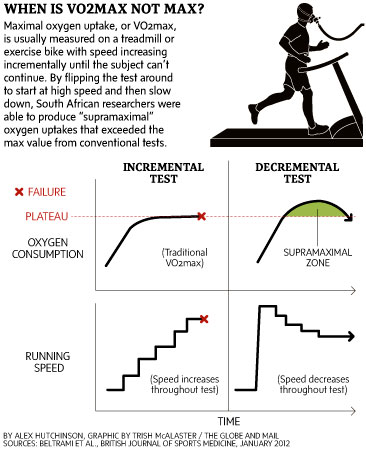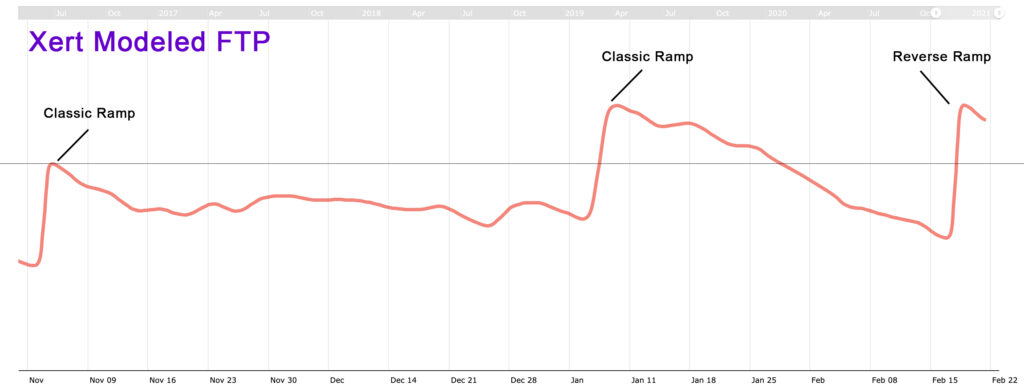Try this reverse ramp workout on Zwift or Trainer Road or RGT to see if it improves your VO2max or FTP.
I’ve been reading a great deal on front-loaded efforts to raise heart rate and then holding on at slightly lower wattage to keep HR in the VO2max zone for longer.
Additionally, a study has shown that VO2max testing efforts might be neurologically limited rather than cardiovascularly limited, as participants were able to go supramaximal in a reversed ramp effort.

As an experiment, I constructed a REVERSE RAMP workout session. I simply took the best 1min data I’ve ever completed on the Zwift ramp test and inverted the ramp. For reference, Zwift uses a 20w increase every 1 minute. So for this workout, it’s a 20w decrease every minute.
Do Your Own Reverse Ramp Test Using This .ZWO File
Simply adjust your FTP slider in Zwift to until the first minute of reverse ramp interval is equal to the best 1-minute wattage of your classic ramp test (or 5 watts higher if you are daring).
It’s a tough workout, but it keeps the HR in the VO2max zone for a long time. The front-loaded effort raises HR rapidly, and then the stepped decreases allows the rider to continue while keeping their HR in Z3 (in a three-zoned polarized system).
Download the Reverse Ramp ZWO Workout from Google Drive Folder (FREE)
Here’s how to import ZWO files into Zwift workouts: https://www.zwift.com/news/11792-importing-and-sharing-custom-zwift-workouts
Into RGT workouts: https://www.youtube.com/watch?v=N-Tc32gp7N4&t=2s
My Results
Interestingly, it pushed up my FTP model 22 watts on Xert’ s FTP model and minimally on WKO5’s FTP model. (They use different expressions and different timeframes of looking back. Xert’s model is more reactive. I am not stating that Xert’s is more accurate. In fact, I think WKO5 is more accurate).
| Traditional Ramp Test affect on mFTP in (Nov 2020) BASELINE | Traditional Ramp Test 2 affect on mFTP (Jan 2021) | Reversed Ramp Workout affect on mFTP (Feb 2021) | |
| Best 1 min max power during test | 376 w | 377 w | 370 w |
| mFTP Xert increase in watts over baseline | baseline | +10 w | +10 w |
| mFTP Xert increase in watts over immediate mFTP before test | +17 w | +20 w | + 22 w |
| mFTP WKO5 increase in watts over baseline | baseline | +0 | +4 w |
| mFTP WKO5 increase in watts over immediate mFTP before test (uses 90 day lookback) | +20 w | +0 | +5 w |
| pVO2max after test WK05 (30 day lookback) and increase from just before test | 310w +16 w | 311w +19w | 316w +7w |

How to Go “Supramaximal”
The next reverse ramp workout I will attempt will be at a higher 1 min start power than any recent ramp test. In this case, it would mean starting the ramp at 380w+ and completing the session.
If this is successful, then the next attempt a few weeks later would mean a 385w starting minute reverse ramp, and so on at 5 watts higher than any successful completion in the future. By using this approach, the rider should be able to go supramaximal as the South African study suggests. This means the sustained power and final minute power in the reverse ramp test will be higher than the regular ramp test done to complete exhaustion.
Easier Mentally than Traditional Ramp
While this is by no means an easy workout, and it will count towards one of your 2-3 hard days per week sessions, there is a positive psychological factor that aids the rider in the session’s completion–diminishing effort rather than increasing effort.
With the reverse ramp, I found myself thinking, “Just endure one more minute and it will get easier.” This was definitely an easier mental approach than a classic ramp test where the thought is, “I’m dying and the next minute is going to get even harder.” But it’s still a difficult session, aka this ain’t no Sweat Spot work.
My Heart Monitor Failure and Missing But Needed Data
UPDATED APRIL 2021: Found the HRM that works extremely well. Durable and even able to be accurate enough to calculate DFA Alpha 1 – The POLAR H10.
I’m still looking for the best heart rate monitor. My problem with HRMs? They stick. Both the Garmin and Wahoo Tickr often seem to hit a point and then stick on that number when I know my heart rate is climbing (or dropping). Sometimes it is a ridiculously low number like 108 and sometimes it’s higher than my Max HR. Usually, it’s just somewhere a bit low–like 130 when I know my HR is at 160+. This seems to happen randomly but frequently, and more often indoors than outdoors. It happens both on the readings in my Garmin 520 head unit and on Zwift via bluetooth.
I’ve tried everything. Pre-wetting the sensor. Taking out the battery, inverting it, and placing it back correctly. Changing the battery. Shaving my chest at contact points. Drying my chest a bit if it becomes sopping wet. You name it, I’ve probably tried it.
If anyone has suggestions, I’m wide open to different brands, strategies, etc.
Unfortunately, this malfunction happened on the second two episodes of this test (aka traditional #2 and reverse ramp). DRATS!
IF the heart rate monitor would have worked, here is what I would be looking for: a comparison of time above 85% V02max heart rate (or stated another way, time above 92% of Max HR). I need to repeat the test with a working HR monitor to see whether the ramp test and reverse ramp workout elicit more time above 85% of VO2max heart rate, and for that matter above 90% and 95% of VO2max heart rate.
Also, if you do this workout, we would love it if you could compare your time above 92% your MAX HR in the classic vs. reversed session. Just leave it as a blog comment like:
Classic time above 92% of max HR = 4min 34 sec
Reversed time above = 4min 42 sec
Not a Replacement for Ramp, 20-minute FTP test or 1 Hour Test
Because the reverse ramp workout has a prescribed dosage of interval length and wattage, it’s not a test in the classic sense, it’s an intense workout. The only “test” is can the rider complete it.
The traditional ramp or 20 minute/1 hour test has the rider willing himself or herself to go a bit further at increasing levels of pain. These tests are still needed to guide FTP wattage. Even if one uses the modeling in WKO5 or Exert, the power curve still needs to be fed this data.
It will be interesting to see if the inclusion of an occasional reverse ramp workout leads to better performance on the traditional ramp test.
Limitations
Yes, I am fully aware that, so far, this is a N=1 experiment. Most of the Meat Motor experiments are. Hopefully, we will get more commenters, but even a large number will still have a large degree of bro-science to it. But bro-science often correlates to lab science. And if it makes me faster, I’ll use all the experiments I can think of.
Dig Deeper?
The study which inspired this experiment: https://pubmed.ncbi.nlm.nih.gov/22167716/ Related Studies https://www.researchgate.net/publication/323416319_Measurement_of_a_True_VO2max_during_a_Ramp_Incremental_Test_Is_Not_Confirmed_by_a_Verification_Phase
A Final Reminder
Steal the ZWO file above and adjust your FTP, not to your current FTP but where the 1st minute of the actual reverse ramp corresponds is equal to or, ideally, 5 watts greater than the maximum power output for 1 minute on your classic ramp test. Let us know of your results and data changes.
Note: Make sure to do a significant warm-up, as you will be coming hard out of the gate. (But then you Zwifters who race should be used to that!)
Upcoming Experiments: test a 5-minute step approach vs. a 1-minute step approach to see how they affect both models for FTP and suggested pVO2max.

Jordan Fowler has experience as a head swimming coach of the Frisco Swim Team, a TAAF-awarded coach, a track and field distance running consultant for select Texas High School runners, and has competed as a triathlete, road runner, and cyclist. Though he is remarkably slower than he was in his 20s and 30s, he still enjoys endurance sports and sports science studies.

